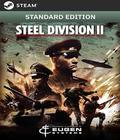Eugen Systems' Wargame series is dense. To win, the game requires an encyclopedia's worth of knowledge about every single one of your units and a mastery of effective real-world tactics. The series remains as high-water marks for strategy game fans, and Steel Division: Normandy 44 proved that the team can make the mechanics work on a more focused theater of war. We're weeks away from the release of Steel Division 2, and to prepare players, the development team has crafted a closed beta that we were able to check out.
The first thing you have to come to grips with in this beta is that you're taught nothing. The game runs under the assumption that you're intimately familiar with the first title, so don't expect any tutorials. Don't even expect to get any tooltips, either. As such, if you're headed into the closed beta, expect to have both online experience and CPU skirmishes teach you the ropes in the most difficult way possible.
If you choose to quickly jump into Steel Division 2, then there are a few basics that make this different from other strategy titles. For starters, the game actually lets you place your units on the map before the match officially starts. Once you begin, you realize that each match is split into phases that last about 10 minutes each. Considering the size of each map, the phases become a reasonable way to partition your forces, as phase A gives you access to quicker and more mobile forces while phases B and C let you deploy units with more firepower. The game also lets you manipulate time in Skirmish mode against the CPU, so you don't have to rush through decisions if you dislike the pacing dictated by most RTS titles. Unlike other strategy games, Steel Division 2 has you fighting for territory control either from a strict attacking or defending standpoint in Breakthrough mode or with an even starting point in Conquest mode.
Aside from the phased structure of each battle, it feels like a typical, polished strategy game. Depending on the AI of your opposition, you'll find that they engage in long-distance attacks and try to flank you. The beta only sports three maps, but the many rivers and tree lines provide great places for cover, and the scattered farmhouses and small towns serve the same purpose. Since you don't have the ability to build units, you can only deploy a finite amount for the whole match. Finally, winning occurs once one side has a slight advantage, giving you a clearer view of how much time you have to stage a counter before being defeated.
Where Steel Division 2 stands out is in unit behavior, which has a few things that aren't prevalent in other titles. While you'd normally obliterate units, they can also be pinned down from enemy fire and may even surrender. Explosions near troops may decrease their morale or briefly shellshock them, and guns on tanks can jam. Airplanes also need constant repair, so you can't always depend on air support. Destroying supply lines means troops can't fire as often, and you'll find that jammed or destroyed communication devices mean that units are unable to travel until the device is repaired. These elements (and more) contribute to battles that are deep enough that anyone who's simply rushing toward targets will see that "strategy" quickly break down.
The beta itself is quite deep compared to some of the other recent betas. Online fights are present, and even though our experience was against a small pool of press members, the online performance was quite good. Skirmish mode pits you against the AI, and you can have a 4v4 experience, which can quickly devolve into chaos. The game's deck-building component, where you can determine which units will be available per phase, is also present, but you'll likely stick with the randomizer or pre-built decks, since there isn't a wide variety of cards in the beta. There's also the chance to view all of the units up close in the hangar. The vehicles look as detailed as ever, but the soldiers look rather flat, but that can be forgiven considering how many units can clog up a battlefield at any time.
Right now, there are a few concerns about the previous title. The first game was released just two years ago, and for such a small studio, longtime players will wonder if the only major differences are a location change to the eastern part of Europe and different units. The other question is whether there's going to be a large enough population to play the game online. The first game reportedly had an online community small enough to get into matches — if you got lucky or scheduled it. It will be interesting if this does better or sees the same fate.
As it stands now, Steel Division II is proving to be an interesting strategy game. Those who played the previous game are better suited to tell if something really changed in the sequel, but newcomers will be fascinated by the mechanics, even if they have to lose multiple times and go up against the easy AI to figure it out. The card-building aspect is interesting, and the win conditions make it different for those who are used to more traditional RTS games, but the random variables (e.g., being pinned down and morale loss) make it feel deeper than expected. Look out for the full release in a few weeks.
More articles about Steel Division II











 Steel Division II is a tactical World War II real-time strategy game set in 1944 on the Eastern Front during one of the biggest offensive of the WW2, Operation Bagration.
Steel Division II is a tactical World War II real-time strategy game set in 1944 on the Eastern Front during one of the biggest offensive of the WW2, Operation Bagration.
































